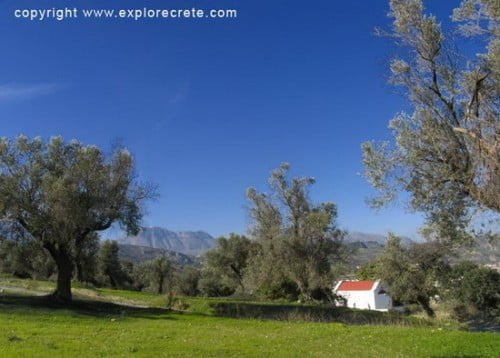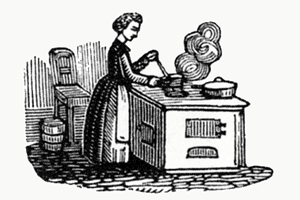History of Olive Oil
Olive tree cultivation and olive oil production has been with humankind since time immemorial, according to evidence that provide the artefacts and archaeological remains of the most ancient civilisations. The olive has been an integral part of life in the eastern Mediterranean from the first stirrings of civilisation.
There are stone mortars and presses used for olive oil extraction that date back to 5000 BC. Archaeological findings from the Minoan Palaces in Crete are fine examples of olive oil’s role in the Cretan or Minoan civilisation, which reached its zenith between 2000 and 1450 BC.
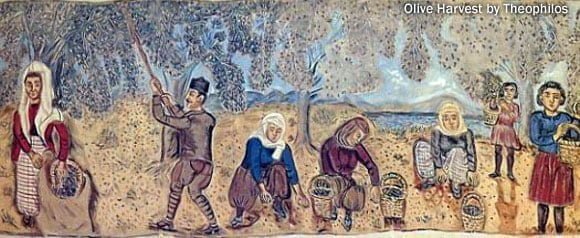
From the time of ancient Egypt into the modern religions, olive oil has been used in religious ceremonies and as an external ointment, and you will find many citations about the olive in the Old Testament and other holy writings. After the Flood, an olive leaf brought by a dove told Noah that the flood waters had abated. Clay tablets from the reign of Nebuchadnezzar listed allocations of oil to Jeboiachin, the young king of Judah, taken prisoner by the Babylonians in 597 BC.
Throughout the various civilisations, the olive tree and olive oil have occupied pivotal positions in the agricultural economy of Mediterranean countries and in their commerce with neighbouring populations. The Minoans of Crete were among the first cultures to achieve prosperity on olive oil, and Crete continues to be an important olive production area to the present day.
History of Olive Oil: Olive Oil in Minoan Crete
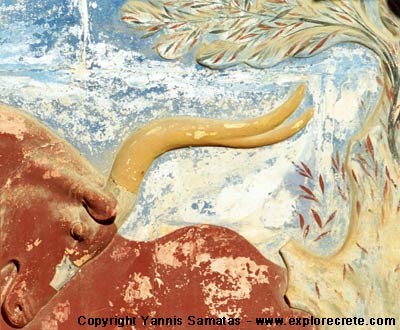
Archaeological finds proving that the Minoans used olive oil in their daily lives are found everywhere in Crete. One particularly impressive discovery is the untouched olives with the flesh preserved, found at the bottom of a cup sunk in a water cistern at the Minoan Palace of Kato Zakros. The Minoans used olive oil in their diet, as a cleanser instead of soap, as the base for scents and ointments, as a medicine, in tanning, for lighting and to protect delicate surfaces.
Ancient stone olive presses have been found in Crete. The one in Vathypetro, Archanes is believed to be the oldest in Europe. Olive oil was stored in large pithoi like those found in the West Magazines of the Minoan Palace of Knossos, with a total estimated capacity of 250,000 kilos.
Traditional scholarship puts the origin of olive trees in ancient Iran and Turkestan. However, other scholars argue that the modern olive tree must have originated in multiple locations, since it seems to have appeared simultaneously in southern Anatolia (now Turkey), Palestine (now Jordan and Israel), and the Levant (now Syria and Lebanon) — countries that, as the ox cart went, were so far from each other in antiquity.
Olive tree cultivation was already widely scattered in the eastern Mediterranean, Egypt, and North Africa by the time the proto-Greeks colonised the Greek peninsula. Cultivation was not a universal activity, and as late as 500 BCE, civil leaders were still exhorting people to grow more olive trees.
Olive Oil in Ancient Greece
The olive tree was a particularly important symbol for the ancient Greeks. It was connected to their diet and their religion, and was used as a decorative motif on vases, in gold jewellery and elsewhere. It was considered a symbol of peace, wisdom and victory. That is why the winners of the Olympic Games were crowned with a wreath of wild olive (the cotinus).
Olives in antiquity were usually gathered by beating the tree with rods, although ancient authors condemned this practice. Pliny repeatedly recommends: “Do not shake and beat your trees. Gathering by hand each year ensures a good harvest.”
The olive-harvesting knowledge of the ancients, incredibly advanced for its time, was often aided by astronomy, used to predict poor harvests. Thales of Miletus, for example, used his astronomical observations to predict an excellent harvest for 596 BC. He immediately established many new oil-presses on Chios and Melos, making the islands’ inhabitants rich in a year. Democritus also studied the relationship between good harvests and the positions of the stars.
Olive oil had many uses in ancient Greece, differing according to social status. Poor people, for instance, did not consume olive oil but ate many cereals. The rich, on the other hand, were able to use olive oil in cooking, for cleaning their bodies and for lighting.
Olive oil was also a valuable medicine in the hands of ancient Greek doctors. Hippocrates mentions 60 different conditions which could be treated with it, such as skin conditions, wounds and burns, gynaecological ailments, ear infections and many others.
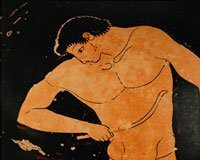
When medicine was not enough to save the patient, olive oil was used in laying out the dead. Women washed the body and anointed it with olive oil or scented oils. Oil, wine, honey and other products were offered to the dead at the graveside.
Another popular use of olive oil in ancient Greece was for oiling athletes’ bodies before exercise in the gymnasium and at games.
Olive oil was also a valuable winner’s prize. The city of Athens needed about 70,000 kilos of oil to reward the winners of the Panathenian Games, held every four years.
The winner’s prize varied according to the event. The best runner received about 70 amphoras of 35-40 kilos, i.e. 2,500 kilos of olive oil, while the chariot-race winner got double, i.e. about 5,000 kilos. These prizes were worth a lot of money if you consider that a day’s wages for an Athenian craftsman was 1 Attic drachma, the equivalent of about 3 kilos of olive oil. And that was just the price of common oil, whereas the winner’s oil was much better quality and more expensive. Of course no-one would buy this oil to eat; instead it was used for anointing the bodies of rich young athletes.
Olive Oil in the Greek colonies
It was the ancient Greeks who introduced the cultivation of the olive to their colonies. The Greek population was growing fast, and after a while, there was no longer enough room for everyone in the cities. The more adventurous among them began moving out and founding Greek colonies in Sicily, southern France, and the west coast of Spain as early as 800 BCE. Other émigrés went east, reaching the shores of the Black Sea. Everywhere they went, they took olive trees with them. In 600 BCE, the Phoenicians were active in the western Mediterranean, and were consolidating their trade routes, buying olive oil from Philistia and the city of Ekron in what is now Israel.
Dealing in olive oil was the backbone of the import-export trade in the ancient world. Merchants came from Phoenicia, Crete and Egypt to the Mediterranean basin and even farther, from 600 BCE onwards. The Scythians of the southern steppes of Russia came to replenish stocks of olive oil at the prosperous Greek trading posts of the Black Sea which later became the spas of Romania. Depositories of oil jars such as those of Komos in Crete are evidence of the importance of the olive oil trade. Olive oil was already liquid gold, ages before fuel oil became known as black gold.
The Romans copied many of the Greek practices as they developed their empire and expanded the olive cultivation the Greeks had started. At first they did not cultivate olive trees in Italy itself but relied on established producers in distant provinces like those in Spain, thus increasing their olive oil trade with the conquered countries of the Roman Empire. After conquering the whole of the Mediterranean and eliminating the last vestiges of Greek power, the Romans began cultivating the olive tree in Italy.
With the fall of the Roman Empire in the fifth century CE and the Barbarian invasion, olive cultivation declined for a millennium. Western Europe entered the Dark Ages, but olive production persisted in the Eastern Roman empire, Byzantium. With recurring invasions by various Christian armies and later the Ottoman conquests, Byzantium was hardly a stable place during these years, but olive cultivation remained an important activity in the land that is now Turkey.
Olive oil regained its ancient role only in the Middle Ages, mainly under the careful influence of religious communities. However, it took much longer before olive oil again became the liquid gold of antiquity.
After the 16th century AD, Europeans introduced the olive tree to the New World and it is now cultivated in California, Mexico, Peru, Chile and Argentina. It is estimated that there are about 800 million olive trees in the world today, the vast majority (95%) in Mediterranean countries. Olive trees are widely cultivated in Greece, far more so than any other fruit tree, comprising 75% of total arboriculture and covering about 15% of agricultural land.
Olive Oil in Languages
The influence and movement of the olive tree and olive oil was very extensive. The words used for olives and olive oil in modern languages still give a hint of these ancient movements. Where the trees were brought by the Greeks, the olive tree was called by the Greek term elaia, today elia, and olive oil was called elaiolado. The Latin word olea is a corruption of elaia. Olea in turn migrated into the Romantic languages, so that even the English word oil reflects that linguistic descent.
Where the olive followed the Phoenician trading routes, words that stem from the Semitic word for olive, zeit, are common: sait, taiti, even tat in Egypt. Further west in Morocco, the olive oil was known by one of these Semitic variants. The Phoenicians were said to be the first to plant olive trees on the Iberian Peninsula. The Romans greatly expanded the orchards, but the Moors thoroughly expunged almost all traces of Rome in their 7th century conquest of Iberia and centuries-long occupation of Spain. Today, traces of Arabic remain in modern Spanish: olive oil is aceite.
© explorecrete.com All Rights Reserved. Reproduction or copying without permission is prohibited.



